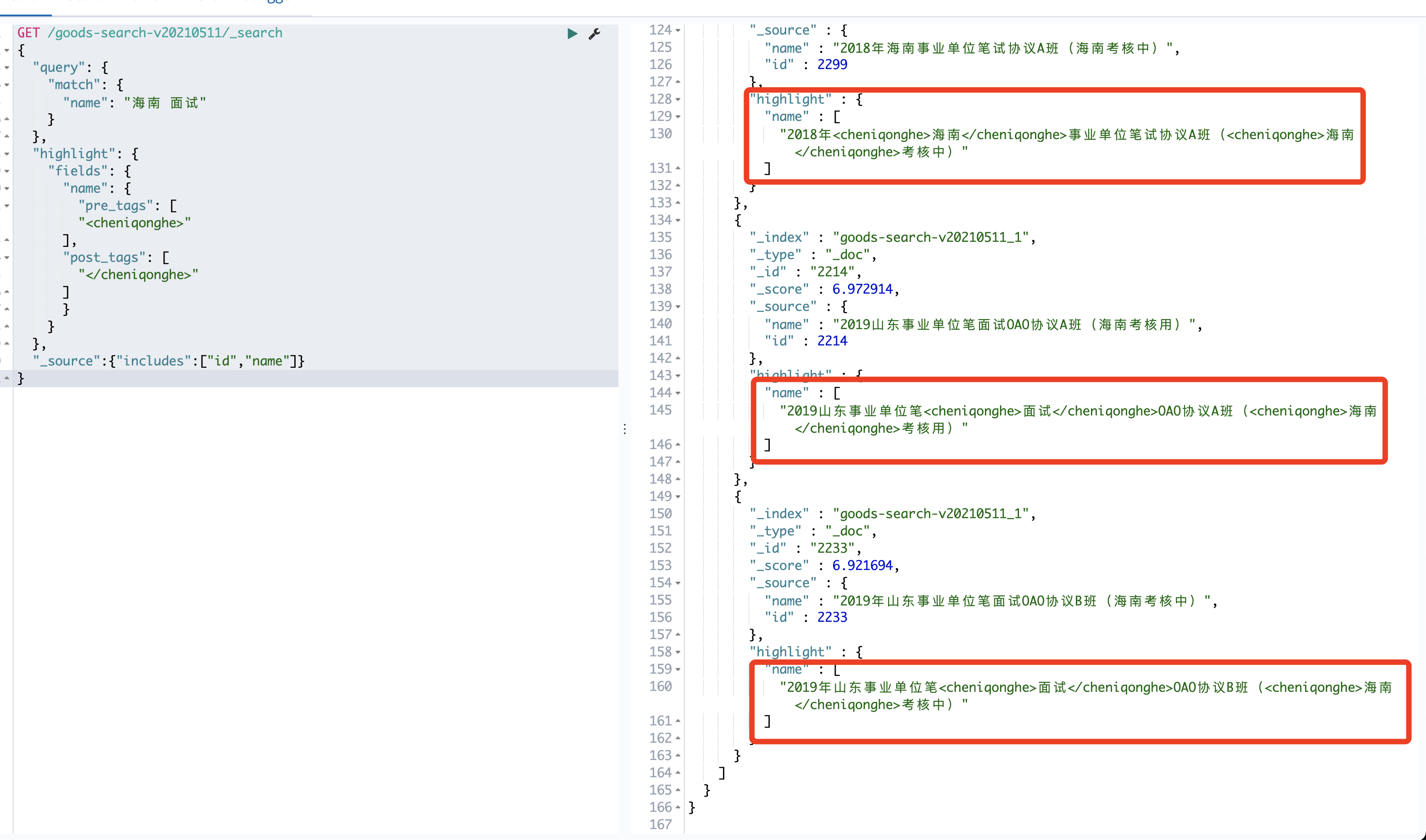前言
Elasticsearch太强大了,强大到跟python一样,一种查询能好几种语法。其实我们用到的可能只是其中的一部分,比如:全文搜索。
我们一般是会将mysql的部分字段导入到es,再查询出相应的ID,再根据这些ID去数据库找出来。
问题来了:数据导入到es后,很多人都要面对这个es的json查询语法,也叫DSL,如下

于是一堆新词来了,比如:filter、match、multi_match、query、term、range,容易让没学过的人抵触。
如果正常开发业务的程序员,只关心原先怎么用sql查询出来的数据,在es中查询出来。
sql查询定位,一般常用的是:=、!=、>、<、and、or、in、between等等。
举个例子,原先sql查询一商品是这样的
SELECT * FROM goods WHERE spu_id = "wp123" OR ( spu_id = "wp345" AND min_price = 30 )
对应到es是
{
"query": {
"bool": {
"should": [
{
"term": {
"spu_id": "wp123"
}
},
{
"bool": {
"must": [
{
"term": {
"spu_id": "wp345"
}
},
{
"term": {
"min_price": 30
}
}
]
}
}
]
}
}
}
sql和dsl是有一定对应关系的,下面把一些常用的总结下,让不熟悉es的童鞋能丝滑能从sql过度
以下内容由chenqionghe倾情提供,祝您es使用愉快
bool-相当于一个括号
用bool包含起来的{},相当用()包含了一个复合查询语句,如上边的
{
"bool": {
"must": [
{
"term": {
"spu_id": "wp345"
}
},
{
"term": {
"min_price": 30
}
}
]
}
}
相当于

看到没有就是这么简单
should-相当于or

must-相当于and

must_not-相当于 ! and
这个就相当于and取反了,
例如:
SELECT * FROM goods WHERE !(shop_id =79)
相当于
{
"query": {
"bool": {
"must_not": [
{
"term": {
"shop_id": "79"
}
}
]
}
}
}
term-相当于=
例如
SELECT * FROM goods WHERE shop_id =79
相当于
{
"query": {
"bool": {
"must": [
{
"term": {"shop_id": "79"}
}
]
}
}
}
terms-相当于in
例如
SELECT * FROM goods WHERE shop_id in (79,80,81)
相当于
{
"query": {
"bool": {
"must": [
{
"terms": {
"shop_id": [79, 80, 81]
}
}
]
}
}
}
range-相当于between
例如
SELECT * FROM goods WHERE id between 1000 and 10005
相当于
{
"query": {
"bool": {
"must": [
{
"range": {
"id": {
"gte": 1000,
"lte": 10005
}
}
}
]
}
}
}
exist相当于is not null
例如
SELECT * FROM goods WHERE id is not null
相当于
{
"query": {
"bool": {
"must_not": [
{
"exists": {
"field": "id"
}
}
]
}
}
}
match-类似match...against
这个match就相当于mysql的全文索引,关于mysql的全文索引,可以看一下这篇文章:从零开始学习MySQL全文索引
举个查询的例子,我要搜索包含 "海南 2018"的词,如下
{
"query": {
"match": {
"name": "海南 2018"
}
}
}
这相当于把所有的“海南”和“2018”记录找出来了,他们是一个or的关系。如果想同时匹配怎么办呢?
可以这样,指定一个operator,默认是用的"or",可以改成这样
{
"query": {
"match": {
"name": {
"query": "海南 2018",
"operator": "and"
}
}
}
}
includes-相当于select
比如
SELECT id,name FROM goods WHERE id = 1765
相当于
{
"query": {
"bool": {
"must": [
{
"term": {
"id": 1765
}
}
]
}
},
"_source":{"includes":["id","name"]}
}
sort-相当于order by
比如
SELECT * FROM goods ORDER BY id DESC
相当于
{
"sort": [
{
"id": {
"order": "desc"
}
}
]
}
from size-相当于limit
例如
SELECT * FROM goods ORDER BY id DESC LIMIT 5,2;
相当于
{
"from": 5,
"size": 2
}
到这里,差不多就已经可以丝滑地从sql过度到es的dsl了
一些常见问题
match和term的区别
match在匹配时会对所查找的关键词进行分词,然后按分词匹配查找,而term会直接对关键词进行查找。一般模糊查找的时候,多用match
query和filter的区别
filter:只查询出搜索条件的数据,不计算相关度分数
query:查询出搜索条件的数据,并计算相关度分数,按照分数进行倒序排序
filter比query性能好,两者可以一起使用
filtered和filter区别
filtered是比较老的的版本的语法。现在已经被bool替代,推荐使用bool。
老版本写法
{
"query": {
"filtered": {
"query": {
"match": {
"text": "quick brown fox"
}
},
"filter": {
"term": {
"status": "published"
}
}
}
}
}
新版本写法
{
"query": {
"bool": {
"must": {
"match": {
"text": "quick brown fox"
}
},
"filter": {
"term": {
"status": "published"
}
}
}
}
}
filter两种用法
嵌套在bool下
{
"query": {
"bool": {
"must": {
"term": {
"term": {
"title": "kitchen3"
}
}
},
"filter": {
"term": {
"price": 1000
}
}
}
}
}
在根目录下使用
{
"query": {
"term": {
"title": "kitchen3"
}
},
"filter": {
"term": {
"price": 1000
}
}
}
term和terms的区别
term相当于where =
terms相当于 where in (xx,xx,xx)
如果想要=于多次,得用多个term,而不是terms
如何高亮关键词
这里需要用到
比如,我们查询包含“海南”和“面试”的词,match指定"海南 面试",highlight指定字段和要包含的标签
GET /goods-search-v20210511/_search
{
"query": {
"match": {
"name": "海南 面试"
}
},
"highlight": {
"fields": {
"name": {
"pre_tags": [
"<cheniqonghe>"
],
"post_tags": [
"</cheniqonghe>"
]
}
}
},
"_source":{"includes":["id","name"]}
}
查询结果如下

可以看到es已经将关键词用指定的标签包起来了
有没有sql生成dsl的工具
有,找到一个:在线sql转dsl
但是这种工具只能是作为辅助,不能完全靠它
- 傻瓜式的生成不一定是最优的
- sql有局限性,比如没有高亮、嵌套查询等等。
我们可以生成,再自己优化成最终的json